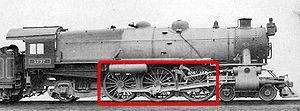On asteam locomotive,adriving wheelis a poweredwheelwhich is driven by thelocomotive'spistons(orturbine,in the case of asteam turbine locomotive).[1]On a conventional, non-articulated locomotive, the driving wheels are all coupled together with side rods (also known ascoupling rods); normally one pair is directly driven by themain rod(orconnecting rod) which is connected to the end of thepiston rod;power is transmitted to the others through the side rods.[2][3][4]


Ondieselandelectric locomotives,the driving wheels may be directly driven by thetraction motors.Coupling rods are not usually used, and it is quite common for each axle to have its own motor.Jackshaftdrive and coupling rods were used in the past[5][6](e.g. in theSwiss Crocodile locomotive[7]) but their use is now confined toshunter locomotives.
On anarticulated locomotiveor aduplex locomotive,driving wheels are grouped into sets with wheels within each set linked together.
Diameter
editDriving wheels are generally larger thanleadingortrailing wheels.Since a conventional steam locomotive is directly driven, one of the few ways to 'gear' a locomotive for a particular performance goal is to size the driving wheels appropriately.[8]Freight locomotives generally had driving wheels between 40 and 60 inches (1,016 and 1,524 mm) in diameter; dual-purpose locomotives generally between 60 and 70 inches (1,524 and 1,778 mm), and passenger locomotives between 70 and 100 inches (1,778 and 2,540 mm) or so.
The driving wheels on express passenger locomotives have come down in diameter over the years, e.g. from 8 ft 1 in (2,464 mm) on theGNR Stirling 4-2-2of 1870 to 6 ft 2 in (1,880 mm) on theSR Merchant Navy Classof 1941. This is because improvements in valve design allowed for higher piston speeds.
Flangeless wheels
editSome long wheelbase locomotives (four or more coupled axles) were equipped withblind drivers.These were driving wheels without the usualflanges,which allowed them to negotiate tighter curves without binding.[9]
Some three-driving-axle locomotives also had flangeless wheels on the middle axle, such as theNZR WH class.
Balancing
editOn locomotives withside rods,including moststeamandjackshaftlocomotives, the driving wheels have weights to balance the weight of the coupling and connecting rods.[10][11]The crescent-shaped balance weight is clearly visible in the picture on the right.
Whyte notation
editIn theWhyte notation,driving wheels are designated by the middle number or numbers in the set.[12][13]TheUIC classificationsystem counts the number of axles rather than the number of wheels and driving wheels are designated by letters rather than numbers. The suffix 'o' is used to indicate independently-powered axles.[14]
The number of driving wheels on locomotives varied quite a bit. Some early locomotives had as few as two driving wheels (one axle). The largest number of total driving wheels was 24 (twelve axles) on the2-8-8-8-2and2-8-8-8-4locomotives. The largest number of coupled driving wheels was 14 (seven axles) on the ill-fated AA204-14-4locomotive.
Other uses of the termdriving wheel
editThe termdriving wheelis sometimes used to denote thedrive sprocketwhich moves thetrackon tracked vehicles such astanksandbulldozers.[15][16]
In popular culture
editMany American roots artists, such asThe Byrds,Tom Rush,The Black Crowesand the Canadian bandCowboy Junkieshave performed a song written byDavid Wiffencalled "Driving Wheel", with the lyrics "I feel like some old engine/ That's lost my driving wheel."[17]
These lyrics are a reference to the traditional blues song "Broke Down Engine Blues" byBlind Willie McTell,1931.[18]It was later directly covered byBob DylanandJohnny Winter.
Many versions of the American folk song "In the Pines"performed by artists such as Leadbelly,Mark Lanegan(onThe Winding Sheet), andNirvana(OnMTV Unplugged In New York) reference a decapitated man's head found in a driving wheel.[19]In addition, it is likely that Chuck Berry references the locomotive driving wheel in "Johnny B. Goode" when he sings, "the engineers would see him sitting in the shade / Strumming with the rhythm that the drivers made."
See also
editReferences
edit- ^Fowler, George L. (1909).Locomotive Dictionary(1909 ed.). New York: The Railroad Age Gazette. p. 37 – via Google Books.
- ^Forney, Matthias N. (1879).Catechism of the Locomotive.New York: The Railroad Gazette. p. 177 – via Google Books.
- ^Rattan, S.S. (2006) [1993].Theory of Machines(second ed.). New Delhi, India: The McGraw-Hill Publishing Company Ltd. p. 560.ISBN0-07-059120-2– via Google Books.
- ^Profillidis, V.A. (2006).Railway Management and Engineering(third ed.). Aldershot, England, and Burlington, VT, USA: Ashgate Publishing. p. 382.ISBN978-0-7546-4854-3– via Google Books.
- ^Ransome-Wallis 2001,pp. 175–176.
- ^Franco, Prof. I.; Labryn, P. (11 November 2013).Internal-Combustion Locomotives and Motor Coaches.Springer. p. 52.ISBN978-94-017-5765-2– via Google Books.
- ^Steimel, Andreas (2008).Electric Traction – Motive Power and Energy Supply.Munich: Oldenbourg Industrieverlag GmbH. p. 38.ISBN978-3-8356-3132-8– via Google Books.
- ^Richey, Albert S.; Greenough, William C. (1915).Electric Railway Handbook(first ed.). New York: McGraw-Hill Book Company. p.586– via Internet Archive.
locomotive driving wheel ratio.
- ^Roesch, F.P. (August 1916). McNamee, John F. (ed.)."Questions and Answers: Distance Traveled by Driving Wheels in Curving".Locomotive Firemen and Enginemen's Magazine.61(2). Columbus, Ohio: Brotherhood of Locomotive Firemen and Enginemen: 136 – via Google Books.
- ^"Another Balancing Scheme".Locomotive Engineering.XI(9). New York: Angus Sinclair Co.: 414 September 1898 – via Google Books.
- ^Herr, E.M.; Bush, S.P.; Lewis, W.H.; Quereau, C.H. (September 3, 1904)."The Rule of Equipoise: In Counter-Balancing Locomotive Driving Wheels".International Railway Journal.XII(1). Philadelphia and Chicago: 18 – via Google Books.
- ^Ransome-Wallis 2001,p. 505.
- ^Inkster, Ian, ed. (2017).History of Technology.Vol. 33. London and New York: Bloomsbury Academic. pp. 55–56.ISBN978-1-4742-3725-3– via Google Books.
- ^Holland, Julian (2011)."Know your Engine: Main line diesel and electric locomotive wheel arrangements".More Amazing and Extraordinary Railway Facts.Newton Abbot: David & Charles.ISBN9781446356838– via Google Books.
- ^Boscawen, Robert (2010) [2001].Armoured Guardsmen.Barnsley, England: Pen & Sword. p. viii.ISBN978-1-84884-317-2– via Google Books.
- ^Simons, Lisa M. Bolt (2010).The Kids' Guide to Military Vehicles.Mankato, MN: Edge Books. p. 7.ISBN978-1-4296-3370-3– via Google Books.
- ^"Lyrics: Driving Wheel".MusixMatch.RetrievedJuly 8,2017.
- ^"Broke Down Engine Blues".Genius.RetrievedJuly 8,2017.
- ^"Lead Belly - In the Pines".Song Meanings.RetrievedJuly 8,2017.
- Ransome-Wallis, P., ed. (2001) [1959].Illustrated Encyclopedia of World Railway Locomotives.Mineola, NY: Dover Publications.ISBN0-486-41247-4– via Google Books.